
Original Link: https://www.anandtech.com/show/1517
AMD Athlon 64 4000+ & FX-55: A Thorough Investigation
by Anand Lal Shimpi on October 19, 2004 1:04 AM EST- Posted in
- CPUs
It's been a good year for AMD; they've been making money (not as much as Intel, but at least they're in the black) and ask the majority of PC enthusiasts and they're recommending AMD chips. There's obviously good reason; the Athlon 64, while not priced as aggressively as AMD's chips in the past, ends up offering better performance than the Pentium 4, for less money. What more could you want?
Recently AMD made the transition to 90nm with their Athlon 64, but did so on lower clocked parts, much like what Intel used to do whenever they would introduce a new manufacturing process. The first 90nm Athlon 64s came in the flavor of 3000+, 3200+ and 3500+ chips on the desktop, and despite initial overclocking success, 2.2GHz was the highest clock speed AMD introduced at 90nm.
There's no hiding the fact that all chip manufacturers have had some issues moving to 90nm. If they had all of their cards lined up beforehand, the biggest unavoidable issue becomes power density, which you can't simply get around regardless of how mature your 90nm process is. Fighting the incredible power densities of these extremely small cores requires a significant rethinking in how the cores are designed, laid out and even the functional nature of the logic these transistors represent.
Not to be held back by the move to 90nm, AMD continued with the release of two new flagship chips: the Athlon 64 4000+ and the Athlon 64 FX-55. We'll get to the specs momentarily, but needless to say that AMD's approach is in significant contrast to what Intel has recently announced. With the axing of the 4GHz Pentium 4, Intel has effectively let AMD win this latest war of high-cost, low yield CPUs at the very high end. While the victory itself may not mean much come next year or this year for that matter, it is a very interesting change in policy over at Intel. Remember the last time there was a similar push for Intel to ramp up clock speed, the decision was much different, and the market was given a 1.13GHz Pentium III that later had to be recalled. Intel's playing it very safe this time around.
AMD on the other hand has a different strategy. When we published a roadmap calling the Athlon 64 4000+ a 2.6GHz 512KB Socket-939 part back in January, we got a strange email from AMD warning us that the specifications of the Athlon 64 could change. We chalked it up to AMD just doing their usual duty whenever we publish data that is not yet publicly available (or talked about for that matter). But it turns out that their caution was not simply from a PR standpoint; today with an Athlon 64 4000+ in our hands AMD didn't release a 2.6GHz Athlon 64, they just re-released an Athlon 64 FX-53 - a 2.4GHz, 1MB L2 cache part, as a regular Athlon 64 4000+.
CPU manufacturing is all about yields, if AMD can make more chips that work by increasing the die size by adding a larger cache instead of upping the clock speed, then that's the route AMD will take. With the Athlon 64 4000+, it's clear what the outcome of AMD's equations was.
The Athlon 64 FX-55 is however, in line with what we expected. Like the 4000+ and all FX processors before it, the FX-55 features a 1MB L2 cache, but AMD managed to crank the chip up to a full 2.6GHz with the help of some tweaked manufacturing.
The FX-55 uses a type of strained silicon developed with one of AMD's partners, but unfortunately at this point AMD is not releasing much information on their implementation of strained silicon. IBM has been demonstrating strained silicon for years now so it is not too much of a surprise that AMD would have access to this technology for use in their CPUs. Intel first introduced strained silicon to desktop CPUs with their 90nm Prescott chips.
We've already talked about strained silicon in the past, but for a quick refresher here's basically what the technology allows. Silicon atoms found in microprocessors are arranged in a relatively repetitive lattice, with the space in between the atoms allowing electrons and thus electrical current to flow through. The spacing between the atoms creates resistance to the flow of electrons, the greater the spacing, the less the resistance, the greater the flow of electrons. Place a layer of silicon next to a layer of a silicon compound with greater atomic spacing (for example Silicon Germanium), and the pure silicon atoms will end up spacing themselves out more to match up with the SiGe lattice, thus straining the silicon lattice. The end result are freer flowing electrons allowing for faster transistor switching, and in this case higher clock speeds.
The big announcement will be whenever AMD brings strained silicon technology down to their 90nm chips, since 130nm advancements won't mean much going forward. It does appear that AMD's manufacturing partnerships are definitely paying off though, which has helped them address manufacturing as a serious weakness in years past.
So here's what we've got: an Athlon 64 4000+ that is basically a FX-53 (but still clock locked for all higher multipliers like a regular Athlon 64), and an Athlon 64 FX-55 that uses a 130nm strained silicon on insulator process to hit 2.6GHz. Pricing on the two chips is, well, pricey: $827 for the FX-55 and $729 for the FX-53 err we mean Athlon 64 4000+.
Alongside AMD's launch of the FX-55 and 4000+, NVIDIA has announced what may be the chipset to get for the Athlon 64: the long awaited nForce4. For a look at this chipset, which we feature in our review today, read our in-depth look at the nForce4.
Model Numbers Help and Confuse
We've chastised AMD in the past for insisting on a model numbering system instead of just reporting actual clock speeds, but for the first time ever, AMD's model numbering system makes a lot more sense than this drivel that Intel has been using to name their LGA-775 Pentium 4s. We get more complaints today from Intel's model numbering system than we've ever had about any other CPU model numbering system in AnandTech history; that includes attempts from AMD and Cyrix to do the same. While this could be too many users used to referring to CPUs by their clock speeds, it is definitely a present day issue.
Here's a quick recap of what Intel's model numbers mean as we're featuring all LGA-775 chips in this review:
CPU Name - Clock Speed - L2 Cache
Pentium 4 560 - 3.6GHz - 1MB
Pentium 4 550 - 3.4GHz - 1MB
Pentium 4 540 - 3.2GHz - 1MB
Pentium 4 530 - 3.0GHz - 1MB
AMD does have an interesting case for model numbers today; with the release of the Athlon 64 4000+ AMD has a total of five 2.4GHz CPUs in their Athlon 64 line:
CPU Name - Clock Speed - L2 Cache - Memory Interface
Athlon 64 4000+ - 2.4GHz - 1MB - 128-bit
Athlon 64 3800+ - 2.4GHz - 512KB - 128-bit
Athlon 64 3700+ - 2.4GHz - 1MB - 64-bit
Athlon 64 3400+ - 2.4GHz - 512KB - 64-bit
Athlon 64 FX-53 - 2.4GHz - 1MB - 128-bit
This is a prime example of where the model numbering system can actually help, differentiating between the three chips, but we also have to make sure to keep AMD honest in their ratings, which is one area we'll be investigating in this review.
The Test
In addition to our usual tests we've included PC World's WorldBench 5, an application based test suite much like Winstone and SYSMark that incorporates many popular applications. Unlike the aforementioned benchmarks, WorldBench does not test multitasking power, rather focusing on single application performance, making it very complementary to our existing benchmarks.
Our hardware configurations are similar what we've used in previous comparisons, with one addition - our Athlon 64 testbed now uses the recently released nForce4 chipset. For a review of that chipset read our own Wesley Fink's review of NVIDIA's latest chipset with SLI support.
AMD Athlon 64 Configuration
Socket-939 Athlon 64 CPUs
2 x 512MB OCZ PC3200 EL Dual Channel DIMMs 2-2-2-10
NVIDIA nForce4 Reference Motherboard
ATI Radeon X800 XT PCI Express
AMD Athlon XP Configuration
Athlon XP 3200+
2 x 512MB OCZ PC3200 EL Dual Channel DIMMs 2-2-2-10
ASUS A7N8X Deluxe nForce2 400 Motherboard
ATI Radeon X800 XT AGP
Intel Pentium 4 Configuration
LGA-775 Intel Pentium 4 and Extreme Edition CPUs
2 x 512MB Crucial DDR-II 533 Dual Channel DIMMs
3-3-3-12
Intel 925X Motherboard
ATI Radeon X800 XT PCI Express
Business/General Use Performance
Business Winstone 2004
Business Winstone 2004 tests the following applications in various usage scenarios:
. Microsoft Access 2002
. Microsoft Excel 2002
. Microsoft FrontPage 2002
. Microsoft Outlook 2002
. Microsoft PowerPoint 2002
. Microsoft Project 2002
. Microsoft Word 2002
. Norton AntiVirus Professional Edition 2003
. WinZip 8.1
AMD has always dominated performance under business applications, which is why in the past they have always been known as a good CPU maker for office applications. Obviously with the K7 and K8 series of processors AMD changed the rules of the game a bit, offering top of the line performance in far more than just office applications. However, despite AMD's improvements in performance elsewhere, the Athlon 64 continues to hold on as the fastest processor for business applications.
Here we see that there is no performance difference between the three 2.4GHz parts, which is to be expected considering the relatively small datasets and correspondingly low bandwidth nature of business applications.
Even the entry level Athlon 64 3200+ is able to outperform Intel's top of the line Pentium 4 560 here. While Intel will argue that performance here doesn't matter, what does matter is that AMD is faster at a lower price point. Even the old Athlon XP 3200+ is able to offer performance similar to the Pentium 4 550.

Office Productivity SYSMark 2004
SYSMark's Office Productivity suite consists of three tests, the first of which is the Communication test. The Communication test consists of the following:
"The user receives an email in Outlook 2002 that contains a collection of documents in a zip file. The user reviews his email and updates his calendar while VirusScan 7.0 scans the system. The corporate web site is viewed in Internet Explorer 6.0. Finally, Internet Explorer is used to look at samples of the web pages and documents created during the scenario."
While the Athlon 64 FX-55 and 4000+ manage to land on top, it isn't by a huge margin. The FX-55 holds just under an 8% performance advantage over Intels Pentium 4 3.4EE. The Pentium 4 550 and Athlon 64 3800+ tie in the middle, while the 3400+ offers statistically similar performance.
What's interesting to note here is that the Athlon XP 3200+ manages to outperform, ever so slightly, the newer Athlon 64 3000+, thanks to a somewhat shorter pipeline and higher clock speed. What these results tell us is that the Communication test is much less dependent on the memory subsystem, rendering the on-die memory controller advantages of the Athlon 64 relatively useless. Our theories are confirmed by the fact that there's virtually no difference in performance in the single and dual channel memory configurations of the Athlon 64. There is, however, a boost in performance when going from a 512KB cache to a 1MB cache (3800+ -> 4000+), indicating that the datasets here are too big for a 512KB cache, but fit much better in a 1MB cache.
The Pentium 4 does relatively well here, with the Prescott based 90nm 560 offering similar performance to the Northwood based 130nm 3.4EE, with the higher clock speed able to make up for Prescott's other shortcomings.

The next test is Document Creation performance, which shows very little difference in drive performance between the contenders:
"The user edits the document using Word 2002. He transcribes an audio file into a document using Dragon NaturallySpeaking 6. Once the document has all the necessary pieces in place, the user changes it into a portable format for easy and secure distribution using Acrobat 5.0.5. The user creates a marketing presentation in PowerPoint 2002 and adds elements to a slide show template."
The inclusion of a speech recognition test as a part of this next benchmark immediately excludes the older generation of processors from being in the running for top performance spots. The lack of an on-die memory controller keeps the Athlon XP 3200+ at the end of the pack, while the more bandwidth friendly Pentium 4 and Athlon 64 platforms battle it out for the lead here.
The Athlon 64 FX-55 manages to secure a small 5% lead over the 3.4EE and the Pentium 4 560. It's not a noticeable performance lead in the real world, but it does stand on paper (or on web if you prefer). We once again see that there's no huge benefit to the 4000+'s 1MB L2 cache, but the dual channel configuration of our Socket-939 platforms clearly comes in handy, resulting in a 7% performance boost for the 3800+ over the single channel 3400+.
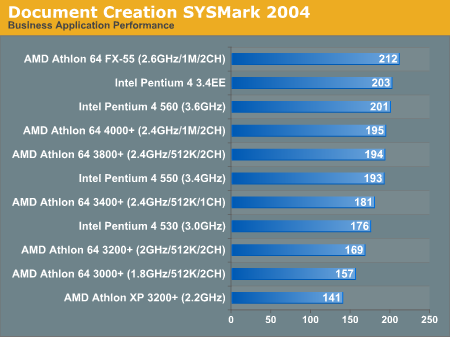
The final test in our Office Productivity suite is Data Analysis, which BAPCo describes as:
"The user opens a database using Access 2002 and runs some queries. A collection of documents are archived using WinZip 8.1. The queries' results are imported into a spreadsheet using Excel 2002 and are used to generate graphical charts."
Although not quite the enterprise level server database, MS Access does get used quite frequently in small to medium sized business environments to handle light database loads.
Here the Pentium 4s completely dominate, with the Prescott core truly extending the performance lead here. None of the AMD chips even stand a chance, not to mention the thrashing that the XP 3200+ gets. The Data Analysis tests do prove that despite the performance in other areas, there are a few pedestals that the Pentium 4 does continue to stand quite high upon.
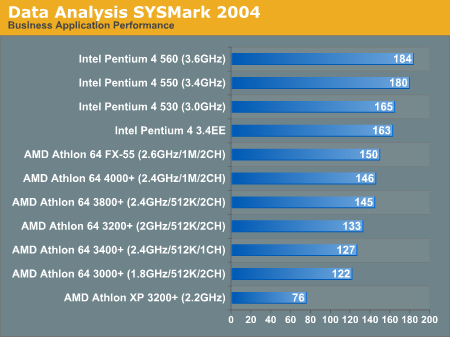
Microsoft Office XP SP-2
Here we see in that the purest of office application tests, performance doesn't vary all too much. The spread of performance here is around 6%, which is nothing terribly significant. While AMD continues to top the charts, Intel is basically on par with them here.
For doing the most basic work in Office, you'll find no real performance difference between a top of the line Intel and AMD machine. Head towards the mid range and you'll still find no real difference in performance, only in price.
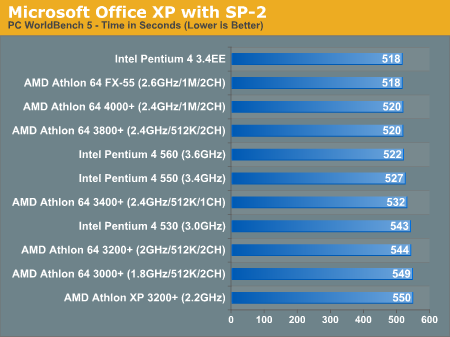
Mozilla 1.4
Quite possibly the most frequently used application on any desktop is the one we pay the least amount of attention to when it comes to performance. While a bit older than the core that is now used in Firefox, performance in Mozilla is worth looking at as many users are switching from IE to a much more capable browser on the PC - Firefox.
Here it's no secret that AMD is clearly on top in performance. What's
truly impressive is that the fastest Athlon 64 is able to complete the Mozilla
test in close to half the time of the Pentium 4 550. The performance advantage
the Athlon 64s hold over the Pentium 4s is impressive to say the least.
We continue to see that a dual channel setup gives the Athlon 64 around
a 5% performance boost. What is quite interesting is the 11% performance
improvement
thanks to a 1MB L2 cache that the 4000+ holds over the 3800+. What
this confirms is that the low memory access latencies provided for
by the
on-die memory
controller
of the Athlon 64 is largely responsible for the performance advantage
here. Looking at the 3.4EE we see that its large L3 cache is able to
make up
for the clock speed deficit, giving it the lead over the Pentium 4
560, further
confirming our statements on what matters when it comes to browser
performance.
Low latency memory accesses matter most here and AMD takes the crown. It is worth noting that you are generally going to be limited by the speed of your Internet connection when it comes to browser performance, however it is always nice to have the snappiest browser experience possible.
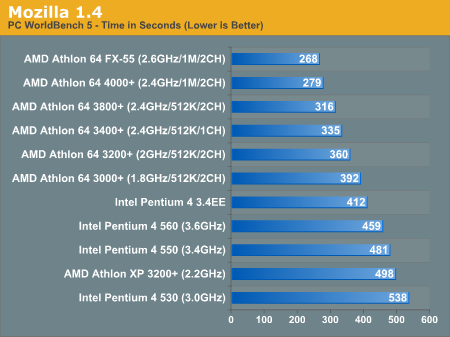
ACD Systems ACDSee PowerPack 5.0
ACDSee is a popular image editing tool that is great for basic image editing options such as batch resizing, rotating, cropping and other such features that are too elementary to justify purchasing something as powerful as Photoshop for. There are no extremely complex filters here, just pure batch image processing.
At 2.4GHz, AMD begins to take the lead from Intel, outperforming even the 3.4EE. The higher up the model number goes, the greater the gap continues to be. There isn't much of a performance difference between the three 2.4GHz chips from AMD, with the biggest difference actually being between the Athlon 64 3800+ and 3400+, or dual vs. single channel memory configurations for those feeling overwhelmed by model numbers. More cache doesn't seem to do much here, as these sorts of operations are largely bandwidth limited and exhibit very little temporal locality with respect to their datasets. We see a 6% gain in performance thanks to the dual channel memory controller of AMD's Socket-939 parts, which is about in line with what we've seen across the board.
The Pentium 4 530 does quite abysmally here, falling behind even the older Athlon XP 3200+. The rest of the Prescott line does appear to do much more reasonably, although at much higher prices than better performing AMD chips.

Ahead Software Nero Express 6.0.0.3
While it was a major issue in the past, these days buffer underrun errors while burning a CD or DVD are few and far between thanks to high performance CPUs as well as vastly improved optical drives. When you take the optical drive out of the equation, how do these CPU's stack up with burning performance?
As you'd guess, they're all pretty much the same, with the slight variations between chips falling within expectations. Any of these chips will do just fine.
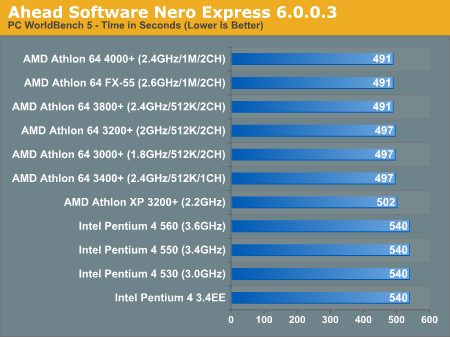
Winzip
Archiving performance ends up being fairly CPU bound as well as I/O limited. Here we continue to see AMD at the top of the charts, closely followed by the high end Intel chips. There's still a 5% performance difference between the single and dual channel 2.4GHz Athlon 64s, which we've been seeing over and over again. We don't see much of a performance boost with the 1MB cache of the 4000+, but the FX-55 does manage to slightly differentiate itself with its higher operating clock.
The Athlon XP does surprisingly well in this test, holding its own against the lower end Athlon 64s.
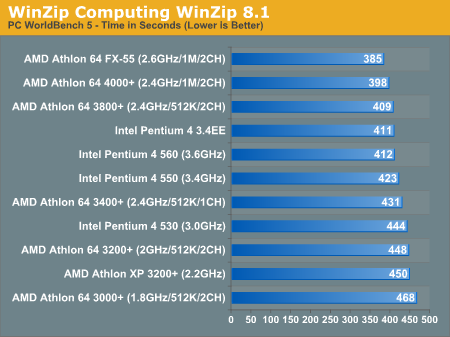
WinRAR 3.40
Pulling the hard disk out of the equation we can get a much better idea of which processors are truly best suited for file compression. While the hard drive hid a lot of the shortcomings of the Athlon XP in WorldBench's WinZip test, they are all revealed in WinRAR's built in benchmark that is largely disk I/O independent.
Here the Athlon 64s show a huge advantage over the Pentium 4 processors, with the slowest Athlon 64 outperforming the fastest Pentium 4 Extreme Edition. The real world performance implications are somewhere in between what we've shown with WorldBench 5's WinZip test and the built-in WinRAR benchmark, needless to say the victor continues to be AMD's Athlon 64.
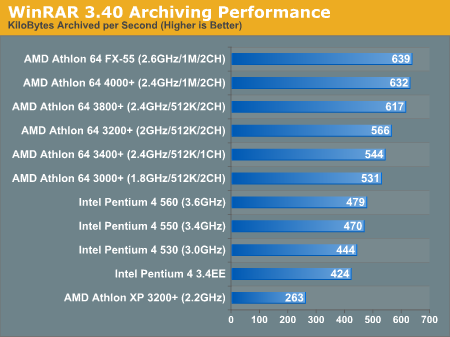
Multitasking Content Creation
MCC Winstone 2004
Multimedia Content Creation Winstone 2004 tests the following applications in various usage scenarios:
. Adobe® Photoshop® 7.0.1
. Adobe® Premiere® 6.50
. Macromedia® Director MX 9.0
. Macromedia® Dreamweaver MX 6.1
. Microsoft® Windows MediaTM Encoder 9 Version 9.00.00.2980
. NewTek's LightWave® 3D 7.5b
. SteinbergTM WaveLabTM 4.0f
As you can see above, Lightwave is part of the MCC Winstone 2004 benchmark suite. As an individual application, Lightwave does manage to get a healthy performance benefit with multithreaded rendering enabled, especially when paired with Hyperthreading enabled CPUs like the Pentium 4s here today. The latest MCC Winstone patch allows for a selection of how many threads to launch during the Lightwave test, the options range from 1 - 8 threads.
Based on our tests it seems as if 4 threads yields the highest performance on the Pentium 4 platform, and thus we used that setting for all of our tests. The Athlon 64s perform identically with 1 or 4 threads as they are not multithreading capable processors, so the AMD scores did not change.
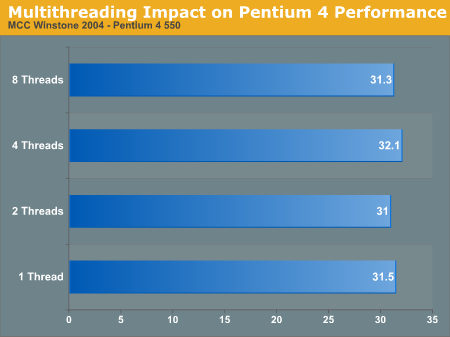
Despite the inclusion of Hyperthreading support, MCC Winstone 2004 still shows AMD performing much better in an area where Intel once dominated. While the Prescott based Pentium 4 560 is at the front of the Intel pack, it is still outperformed by the Athlon 64 3400+.
Here the single vs. dual channel memory gap shrinks to under 3% when we compare the 3400 and 3800+ processors, but also worth noting that the added cache of the 4000+ is also only responsible for about a 2% performance gain. Put the two together and you've got a decent combination in the Athlon 64 4000+, but separately the features don't bring much to the table to justify the added cost.
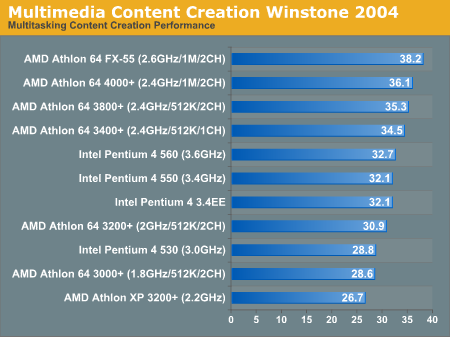
ICC SYSMark 2004
The first category that we will deal with is 3D Content Creation. The tests that make up this benchmark are described below:
"The user renders a 3D model to a bitmap using 3ds max 5.1, while preparing web pages in Dreamweaver MX. Then the user renders a 3D animation in a vector graphics format."
Intel has historically done very well under SYSMark 2004, especially when it comes to Internet Content Creation applications. Here we've got a number of very NetBurst friendly applications running at the same time and the results aren't too surprising.
For once we have the Pentium 4 560 out on top, distancing itself from the Athlon 64 FX-55 by almost 5%. The Prescott core flexes its muscle as the longer pipeline does it no harm, with the Pentium 4 550 performing on level ground with the Northwood based 3.4EE.
The three 2.4GHz AMD chips settle in the middle of the pack, followed by the Pentium 4 530 and the remaining Athlon 64s and Athlon XP. 3D rendering continues to be a strongpoint for the Pentium 4, with the combination of 3D rendering and animation giving Intel the much needed lead here.
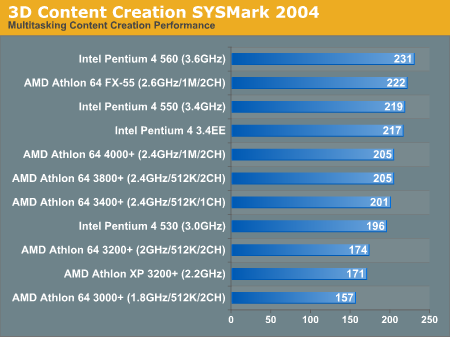
Next, we have 2D Content Creation performance:
"The user uses Premiere 6.5 to create a movie from several raw input movie cuts and sound cuts and starts exporting it. While waiting on this operation, the user imports the rendered image into Photoshop 7.01, modifies it and saves the results. Once the movie is assembled, the user edits it and creates special effects using After Effects 5.5."
The race is much closer in the 2D Content Creation test, with the Pentium 4 560 virtually tied for the lead with AMD's Athlon 64 FX-55.
Once again we see no difference between the 512KB L2 3800+ and the new 4000+ armed with a 1MB L2 cache. There continues, however, to be a slight performance impact when going down to the single channel Athlon 64 3400+.
Looking at the Athlon XP we see just how important the Athlon 64 has been
to AMD, without it we'd be analyzing another Intel dominated test.
Here's another situation where Prescott seems to be breaking even when
it comes to performance. Remember that Prescott's lengthened pipeline should
penalize it significantly, but thanks to Prescott's other core optimizations
and larger cache it manages to perform just as well as the Northwood based
Extreme Edition here.
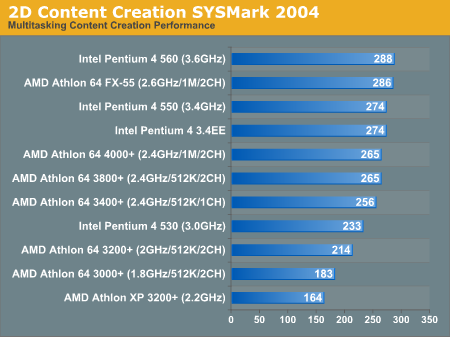
The Internet Content Creation suite is rounded up with a Web Publishing performance test:
"The user extracts content from an archive using WinZip 8.1. Meanwhile, he uses Flash MX to open the exported 3D vector graphics file. He modifies it by including other pictures and optimizes it for faster animation. The final movie with the special effects is then compressed using Windows Media Encoder 9 series in a format that can be broadcast over broadband Internet. The web site is given the final touches in Dreamweaver MX and the system is scanned by VirusScan 7.0."
The situation remains mostly unchanged in SYSMark's final Internet Content Creation test. The Pentium 4 560 heads up the pack, followed very closely by the Athlon 64 FX-55 as well as the Pentium 4 550 and 3.4EE.
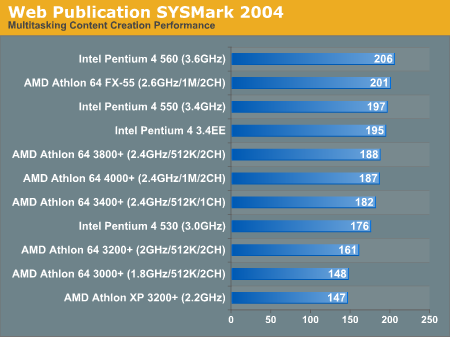
Mozilla + Media Encoder
While AMD dominated in WorldBench 5's Mozilla test, encoding a file using Windows Media Encoder in the background not only makes this test more appreciative of the Pentium 4 but also of Hyper Threading.
Despite the seemingly perfect Hyper Threading scenario, it doesn't help Intel win the lead here. The Athlon 64 FX-55 and the 4000+ manage to win here, followed by the 3.4EE. Without any spatial locality between the two very different applications being run enabling Hyper Threading essentially gives each one of the applications half of the cache they would have running solo, thus giving the 3.4EE an advantage over the Pentium 4 560.
We also see that the cache advantage is clearly present on the AMD side as well, with the 4000+ enjoying a 6.7% advantage over the 3800+, with the only difference between the chips being an additional 512KB of L2 cache.
The rest of the results are no surprise given the leaders, the Athlon 64 continues to be quite strong here.
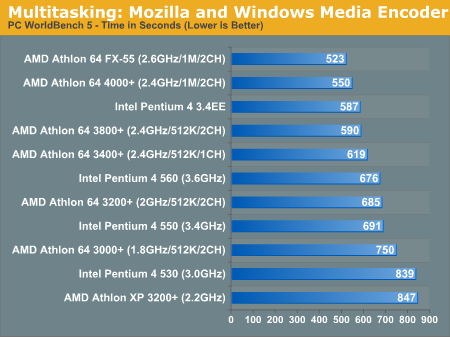
Video Creation/Photo Editing
Adobe Photoshop 7.0.1
With the later releases of the Athlon XP, AMD began to offer fairly solid performance in Photoshop but with the Athlon 64 AMD managed to seal their fate - making AMD the platform of choice for Photoshop users.
The Top four spots in WorldBench's Photoshop 7 test are won by AMD, first by the 2.6GHz FX-55 and then by the three chips at 2.4GHz. As we've seen in the past, image editing doesn't benefit all that much from high bandwidth memory subsystems, so there's little benefit from a larger cache (0.3%) or from a dual channel memory setup (2.7%).
Despite its higher clock speed, the Pentium 4 560 takes a back seat to the Extreme Edition, justifying the EE's continued presence for a little while longer. Though with plans for a Pentium 4 4GHz scrapped, it seems like we'll be seeing a lot more of the Extreme Edition.
Athlon XP owners will find little reason to upgrade to an entry-level Athlon 64 for Photoshop use, as the two 3200+s manage to perform very similarly despite architecture and clock speed differences.
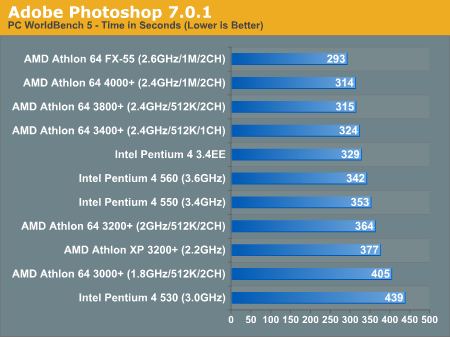
Adobe Premier 6.5
Prescott seems to do quite a bit for Intel here, with the 560 and 550 easily offering better performance than the 3.4EE, despite smaller caches. That being said, even the top of the line Pentium 4 560 can't outperform even the Athlon XP 3200+ in this test. While WorldBench does use an older version of Premier, it is one that is still widely used, making these results quite pertinent.
Once again we see very little need for the larger cache of the Athlon 64 4000+, but more of a tangible benefit from the move to Socket-939 from Socket-754 (6.7%).
AMD simply dominates this test; Premier users should know what platform is right for their needs.
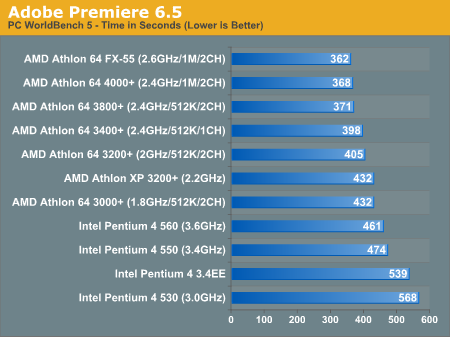
Roxio VideoWave Movie Creator 1.5
While Premier is a wonderful professional application, consumers will prefer something a little easier to use. Enter: Roxio's VideoWave Movie Creator, a fairly full featured yet consumer level video editing package.
Intel has worked very closely with Roxio in the past, thus it's no surprise to see Movie Creator take advantage of the Prescott core as best as possible. The Extreme Edition still takes the crown, but the 560 and 550 manage to keep AMD's best at bay.
The Athlon 64 FX-55 is still within striking distance of the 3.4EE at only a 5% deficit, but the gap grows as we look at cheaper AMD solutions. Intel wins here with AMD in a close second.
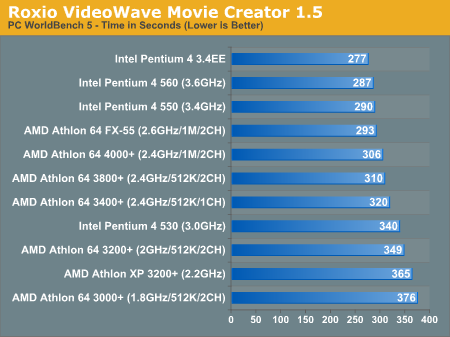
Audio/Video Encoding
MusicMatch Jukebox 7.10
An audio encoding favorite of Intel's from past Pentium 4 launches, MusicMatch Jukebox shows the Pentium 4 3.4EE taking a small 3.5% lead over the FX-55. Despite Intel's first place victory here, AMD takes the next four spots. Once again we see that there's no performance difference between the 3800+ and the 4000+, but looking at the lack of performance improvement from the 3400+ to 3800+ jump we see why: MP3 encoding is quite CPU bound, larger caches and more memory bandwidth don't matter much, it's all about clock speed here. Thus it's not too surprising to see the Athlon XP 3200+ outperform the Athlon 64 3200+ thanks to a shorter pipeline and higher clock speed. AMD's on-die memory controller does little for it here, neither does Intel's Prescott core though.
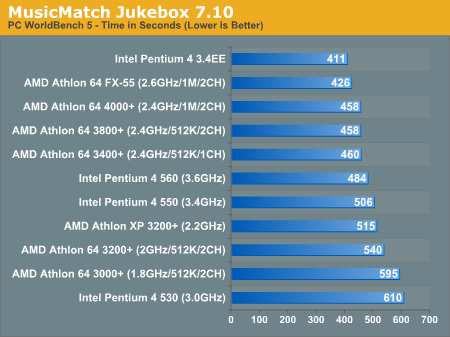
DiVX 5.2.1 with AutoGK
Armed with the latest version of DiVX (5.2.1) and the AutoGK front end for Gordian Knot, we took all of the processors to task at encoding a chapter out of Pirates of the Caribbean. We set AutoGK to give us 75% quality of the original DVD rip and did not encode audio.
Despite AMD becoming more competitive in DiVX encoding performance, Intel once again pulls head, with the Pentium 4 560 pulling away as the fastest DiVX encoder out of the bunch. Even the more reasonably priced Pentium 4 550 is able to outperfom the Athlon 64 FX-55, and it's not until we drop down to the 3GHz mark that AMD is able to win any ground.
Heavy optimizations for NetBurst give Intel the DiVX encoding performance crown.
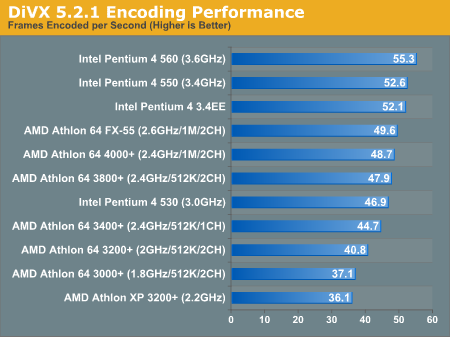
XViD with AutoGK
Another very popular codec is the XViD codec, and thus we measured encoding performance using it instead of DiVX for this next test. The rest of the variables remained the same as the DiVX test.
Using XViD the performance situation is flipped on us, this time instead of Intel being on top we're left with the Athlon 64 FX-55 - although it's worth mentioning that the Pentium 4 560 is close behind. To no surprise there's a noticeable increase in performance from the single channel 3400+ to the dual channel Socket-939 3800+ of 7% to be exact. Once again we see no performance boost for the additional cache of the Athlon 64 4000+.
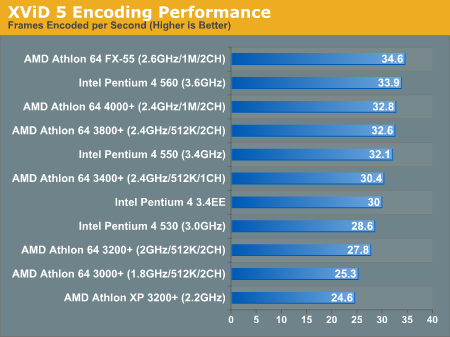
Windows Media Encoder 9
To finish up our look at Video Encoding performance we've got two tests both involving Windows Media Encoder 9. The first test is WorldBench 5's WMV9 encoding test.
Here we see that the Athlon 64 FX-55 and Pentium 4 3.4EE are basically tied for the first place position, followed by the Pentium 4 560 and all of the 2.4GHz Athlon 64s. Here the Athlon 64 3400+ appears to do about as well as the Pentium 4 550, which is either saying a lot for the Pentium 4 550 or very little for the 3400+.
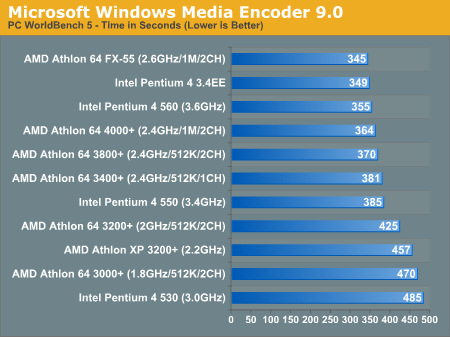
But once we crank up the requirements a bit and start doing some HD quality
encoding under WMV9 the situation changes dramatically.
Here the Pentium 4 560 takes the lead, followed by the Pentium 4 3.4EE
and then the FX-55. The performance difference between the Pentium 4 560
and
the FX-55 is just under 9%, enough to give Intel the clear win here. Only
the Pentium
4 530 is really able to be challenged by the AMD chips.

Closing up our video encoding tests, while AMD does win some, with appropriate optimizations in place Intel seems to be the right candidate here.
Gaming
Doom 3
Our Doom 3 CPU Battlegrounds article already made it quite clear that Intel did not have what it takes to be the highest performer in Doom 3. The release of the Athlon 64 4000+ and FX-55 further extend AMD's lead in Doom 3.
Even the entry level Athlon 64 3200+ has no problems outperforming the 3.4EE
and Pentium 4 560. Doom 3 does continue to show us the ~7% performance improvement
we've been seeing thus far from going to a dual channel Socket-939 setup
over Socket-754. The added cache of the 4000+ manages to yield a 3% performance
improvement over the 3800+, definitely not worth the added premium over an
already expensive chip.
Prescott does well here (for Intel), but the Extreme Edition still takes the
cake.
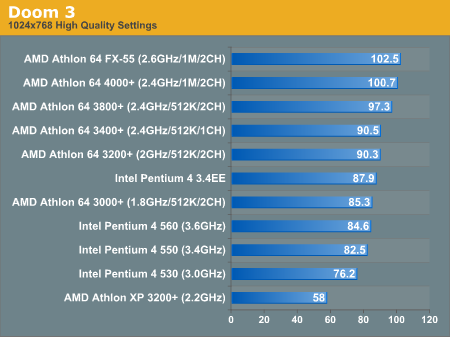
Counterstrike: Source
The next big game after Doom 3 is, of course, Half Life 2. And while the game is still not out, Valve's Visual Stress Test that comes with Counterstrike: Source gives us a good glimpse into future performance under Half Life 2.
Just like Doom 3, Half Life 2 is strictly an AMD dominated game. The Athlon 64 FX-55 outperforms the fastest Intel CPU here by a whopping 18%. Prescott performs horribly, with the Pentium 4 560 only able to outperform the Athlon XP 3200+, not even the Athlon 64 3000+.
What is extremely interesting here is the impact of memory bandwidth on the Athlon 64 platform. The impact of a dual channel memory controller is nothing short of 14%, which is almost double of what we've seen in other tests. The Athlon 64 4000+ also shows a similarly impressive performance improvement due to its larger L2 cache, putting it a full 8% faster than the 3800+.
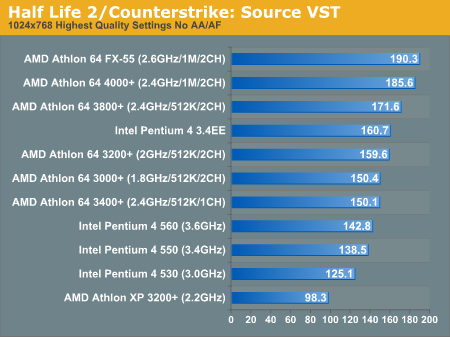
So far in gaming, AMD takes it 2 for 2.
Halo
The gaming performance dominance continues under Halo 1.05, with AMD taking the top three spots. We see much less of an impact from a larger L2 cache on the Athlon 64 platform than we did in the CS: Source VST, but dual channel is still worth close to 6% for the Athlon 64.
Prescott once again doesn't fare very well, with the 3.4EE leading the pack from Intel.
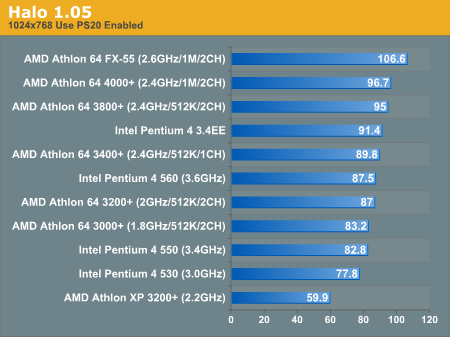
That's 3 for 3 for AMD.
Starwars Battlefront
We recently introduced Starwars Battlefront into our GPU tests last week with the release of NVIDIA's GeForce 6200. This week we're using the same test for AMD's CPU launch.
Overall we see that there's not much variance with CPU speed in Battlefront; obviously the XP 3200+'s performance is a bit dated, but the majority of the contenders here end up performing rather similarly to one another.
AMD does end up on top once again, which is not a surprise considering what we've seen in the past three tests. It would be very safe to say that AMD's Athlon 64 architecture with its on-die memory controller is very well suited for gaming performance.
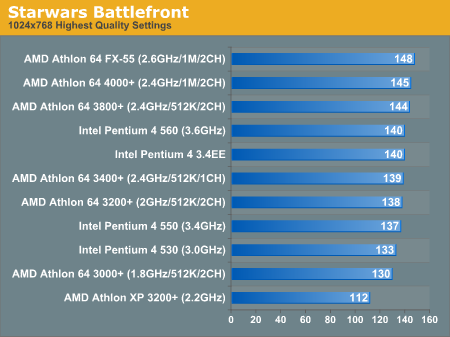
Battlefield Vietnam
Battlefield Vietnam is similar to Starwars Battlefront not only in its gameplay but also in its performance; there's no real difference between any of the top performers here. Almost all l of these CPUs end up being GPU limited at 1024x768.
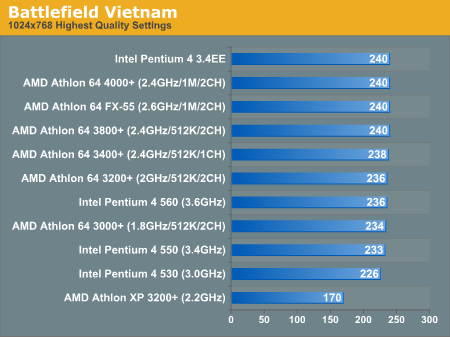
Unreal Tournament 2004
UT2004 sends AMD back to the top of the performance charts, with the top four spots once again belonging to AMD. We also find that the 4000+ improves performance by about 5% due to its larger cache, while the 3800+ continues to make a 6.7% argument in favor of Socket-939 over Socket-754.
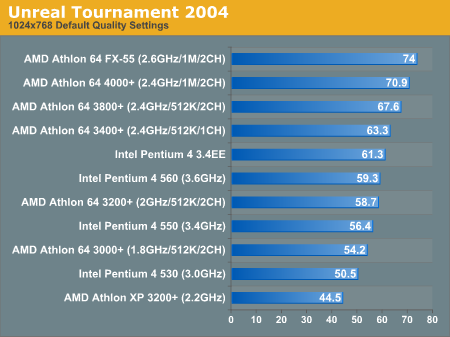
Wolfenstein: Enemy Territory
An oldie but a goodie, Enemy Territory is still played quite a bit and makes for a great CPU test as today's GPUs can easily handle the rendering load of the Quake 3 based game.
We continue to see dominance from AMD, this time only the top three spots go to AMD chips. The Pentium 4 3.4EE and the Pentium 4 560 both manage to outperform the Athlon 64 3400+ thanks to its single channel memory configuration. ET also shows us a situation where the move to dual channel actually helps the Athlon 64 more than the 7% we've been seeing thus far, here an 11% boost is what we see - although there's barely any performance improvement from the larger cache of the 4000+.
Prescott does reasonably well here, but just not good enough to compete with AMD.
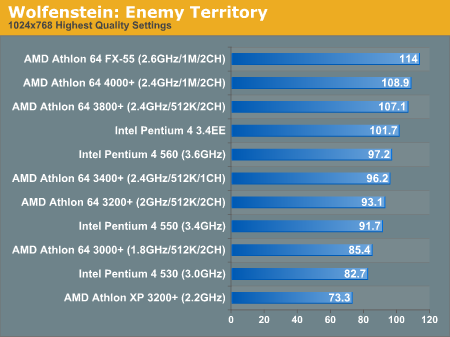
The Sims 2
While a clear departure from our usual game tests, The Sims 2 is more popular than any of the other games we've featured here in certain crowds - it is effectively the Doom 3 of those who prefer life-simulation to first person shooters. And interestingly enough, it makes for a very impressive CPU benchmark.
So who wins the hearts and performance of The Sims? AMD of course, with the top five performers in this test being Athlon 64 processors. Coming in 6th place is the Pentium 4 3.4EE, which is a whopping 21% slower than the Athlon 64 FX-55.
Granted most Sims players will not be shelling out $1,000 for a CPU, but given that the Athlon 64 3200+ can outperform the 3.4EE, they won't have to. Things are back to normal here with a 6% boost from Socket-939 and a minor 2% improvement when the Athlon 64 is given a full megabyte of cache.

Far Cry
Performance under Far Cry echoes what we've already seen, AMD takes the top four spots without much struggle from Intel. While there is some debate about which is the faster content creation chip, there's no debate that the Athlon 64 is the faster gaming chip.
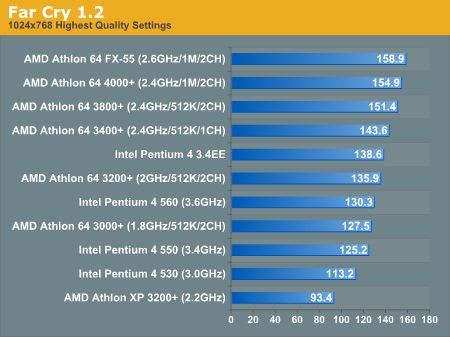
Warcraft III
Although AMD comes out on top here, the performance lead is nothing to cheer about; with the exception of the Athlon XP 3200+, all of the contenders here are GPU bound and all play the game very well (including the Athlon XP).
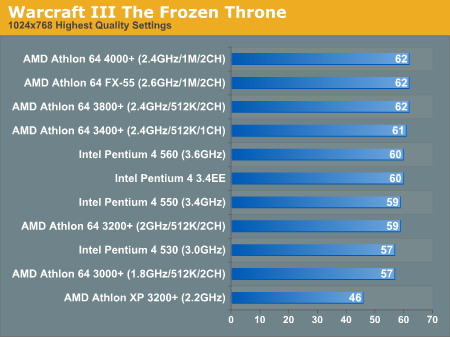
3D Rendering
3dsmax 5.1
WorldBench includes two 3dsmax benchmarks using version 5.1 of the popular 3D rendering and animation package: a DirectX and an OpenGL benchmark. The performance standings don't change between the two, only the actual numbers themselves, so we'll only talk about the OpenGL numbers while displaying both.
AMD manages to take the lead in WorldBench's test, with the FX-55, 4000+ and 3800+ all outperforming the Pentium 4 560. The 3.4EE doesn't appear to carry its weight too well as it is outperformed by the single channel Athlon 64 3400+. Also pay attention to the margin of victory here though, most of the top performing parts here are actually within a couple of percentage points of one another, nothing too significant.
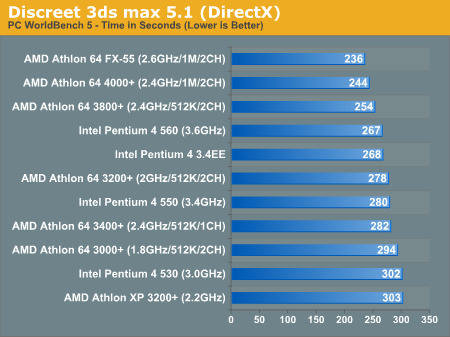
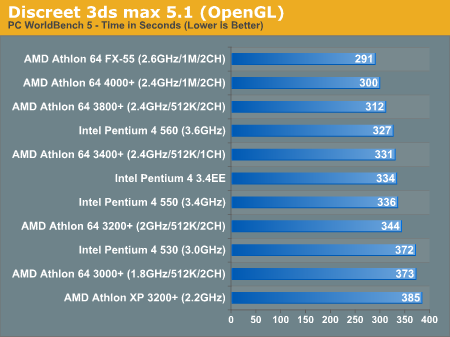
3dsmax 6
For the next 3dsmax test we used version 6 of the program and ran the SPECapc rendering tests to truly stress these CPUs. We've reported the Rendering Composite score for easy comparison to the benchmarks in SPEC's database as well as for a quick set of numbers to look at and compare, however for those that are interested we have also provided the render times for the four benchmarks that go into the Rendering Composite score.
While AMD took the lead in WorldBench's 3dsmax 5.1 test, in the SPECapc 3dsmax 6 test, Intel's Pentium 4 3.4EE holds on to the lead. AMD actually only makes one appearance in the top four performers, basically tying with the Pentium 4 560.
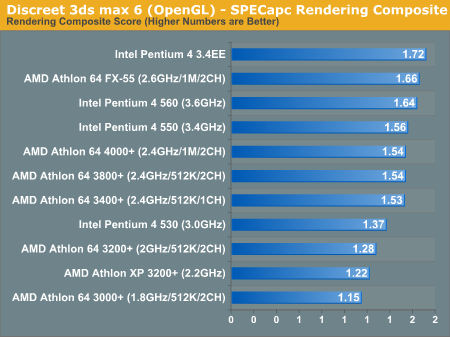
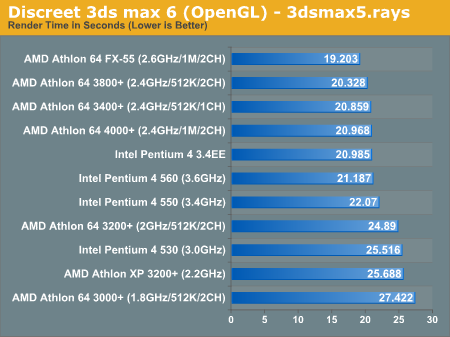
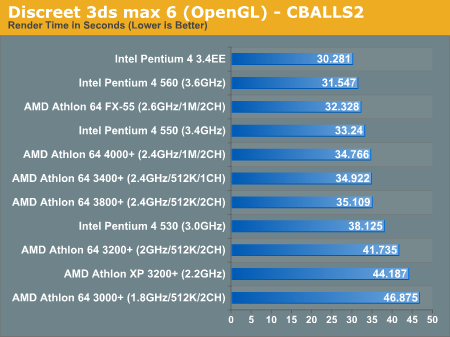
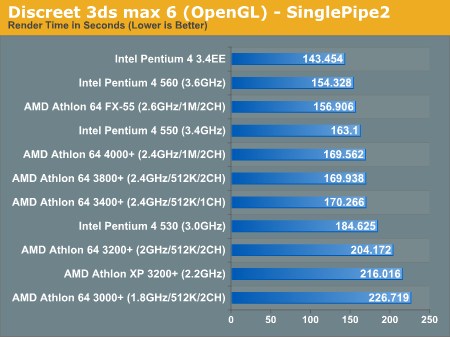
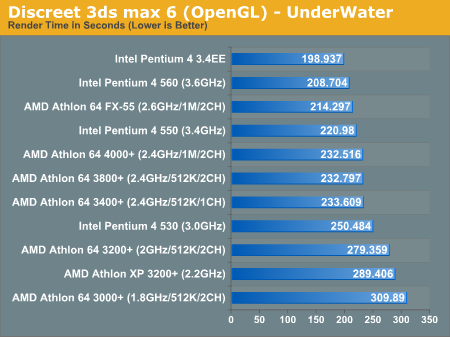
Workstation Applications
Visual Studio 6
Carried over from our previous CPU reviews, we continue to use Visual Studio 6 for a quick compile test. We are still using the Quake 3 source code as our test and measure compile time in seconds. The results are pretty much in line with what we've seen in the past.
Without compiler speed optimizations for NetBurst, the Pentium 4 architecture is not very well suited for highly branchy applications such as compiling and code optimization. The Athlon 64 is far better suited for this type of usage pattern and thus AMD wins the compiler test.
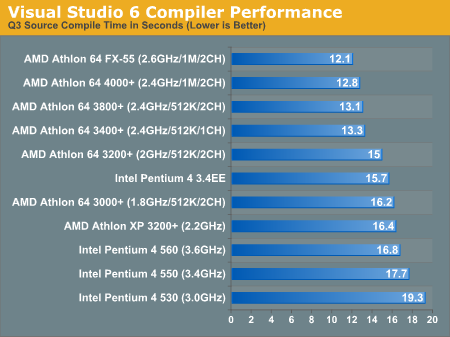
SPECviewperf 8
For our next set of professional application benchmarks we turn to SPECviewperf 8. SPECviewperf is a collection of application traces taken from some of the most popular professional applications, and compiled together in a single set of benchmarks used to estimate performance in the various applications the benchmark is used to model. With version 8, SPEC has significantly improved the quality of the benchmark, making it even more of a real world indicator of performance.
We have included SPEC's official description of each one of the 8 tests in the suite.
3dsmax Viewset (3dsmax-03)
"The 3dsmax-03 viewset was created from traces of the graphics workload generated by 3ds max 3.1. To insure a common comparison point, the OpenGL plug-in driver from Discreet was used during tracing.
The models for this viewset came from the SPECapc 3ds max 3.1 benchmark. Each model was measured with two different lighting models to reflect a range of potential 3ds max users. The high-complexity model uses five to seven positional lights as defined by the SPECapc benchmark and reflects how a high-end user would work with 3ds max. The medium-complexity lighting models uses two positional lights, a more common lighting environment.
The viewset is based on a trace of the running application and includes all the state changes found during normal 3ds max operation. Immediate-mode OpenGL calls are used to transfer data to the graphics subsystem."
The biggest surprise here is that there is a huge performance impact (13%) by moving down to a single channel memory subsystem with the Athlon 64. There are also a couple of other surprises, with the Pentium 4 560 doing surprisingly well, coming in at the heels of the Athlon 64 FX-55.
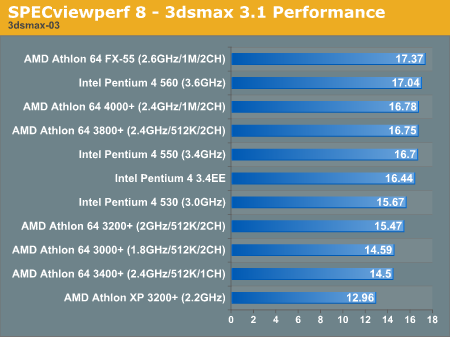
CATIA Viewset (catia-01)
"The catia-01 viewset was created from traces of the graphics workload generated by the CATIATM V5R12 application from Dassault Systemes.
Three models are measured using various modes in CATIA. Phil Harris of LionHeart Solutions, developer of CATBench2003, supplied SPEC/GPC with the models used to measure the CATIA application. The models are courtesy of CATBench2003 and CATIA Community.The car model contains more than two million points. SPECviewperf replicates the geometry represented by the smaller engine block and submarine models to increase complexity and decrease frame rates. After replication, these models contain 1.2 million vertices (engine block) and 1.8 million vertices (submarine).
State changes as made by the application are included throughout the rendering of the model, including matrix, material, light and line-stipple changes. All state changes are derived from a trace of the running application. The state changes put considerably more stress on graphics subsystems than the simple geometry dumps found in older SPECviewperf viewsets.
Mirroring the application, draw arrays are used for some tests and immediate mode used for others."
The single channel Athlon 64 3400+ does exceptionally poorly here, with the dual channel Athlon 64 parts holding a significant performance advantage. By now it's no surprise to see the FX-55, 4000+ and 3800+ at the top of the charts.
Interestingly enough, the CATIA benchmark appears to favor Intel's Prescott core over Northwood.

EnSight (ensight-01)
"The ensight-01 viewset replaces the Data Explorer (dx) viewset. It represents engineering and scientific visualization workloads created from traces of CEI's EnSight application.
CEI contributed the models and suggested workloads. Various modes of the EnSight application are tested using both display-list and immediate-mode paths through the OpenGL API. The model data is replicated by SPECviewperf 8.0 to generate 3.2 million vertices per frame.
State changes as made by the application are included throughout the rendering of the model, including matrix, material, light and line-stipple changes. All state changes are derived from a trace of the running application. The state changes put considerably more stress on graphics subsystems than the simple geometry dumps found in older viewsets.
Mirroring the application, both immediate-mode and display-list modes are measured."
No 925X based test system would complete this test, thus all we have are AMD chips to look at. Once again we see that the 3400+ is seriously crippled by its single channel memory interface.

Lightscape Viewset (light-07)
"The light-07 viewset was created from traces of the graphics workload generated by the Lightscape Visualization System from Discreet Logic. Lightscape combines proprietary radiosity algorithms with a physically based lighting interface.
The most significant feature of Lightscape is its ability to accurately simulate global illumination effects by precalculating the diffuse energy distribution in an environment and storing the lighting distribution as part of the 3D model. The resulting lighting "mesh" can then be rapidly displayed."
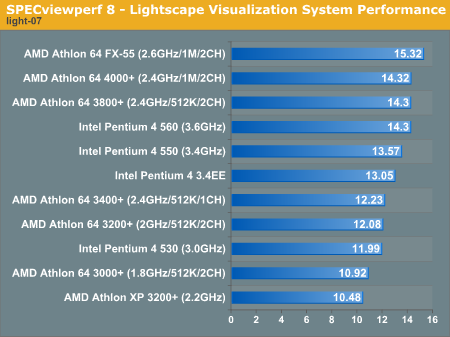
Maya Viewset (maya-01)
"The maya-01 viewset was created from traces of the graphics workload generated by the Maya V5 application from Alias.
The models used in the tests were contributed by artists at NVIDIA. Various modes in the Maya application are measured.
State changes as made by the application are included throughout the rendering of the model, including matrix, material, light and line-stipple changes. All state changes are derived from a trace of the running application. The state changes put considerably more stress on graphics subsystems than the simple geometry dumps found in older viewsets.
As in the Maya V5 application, array element is used to transfer data through the OpenGL API."
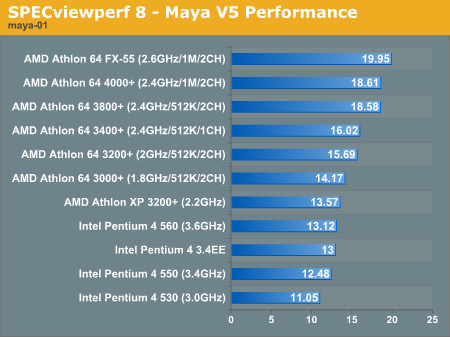
Pro/ENGINEER (proe-03)
"The proe-03 viewset was created from traces of the graphics workload generated by the Pro/ENGINEER 2001TM application from PTC.
Two models and three rendering modes are measured during the test. PTC contributed the models to SPEC for use in measurement of the Pro/ENGINEER application. The first of the models, the PTC World Car, represents a large-model workload composed of 3.9 to 5.9 million vertices. This model is measured in shaded, hidden-line removal, and wireframe modes. The wireframe workloads are measured both in normal and antialiased mode. The second model is a copier. It is a medium-sized model made up of 485,000 to 1.6 million vertices. Shaded and hidden-line-removal modes were measured for this model.
This viewset includes state changes as made by the application throughout the rendering of the model, including matrix, material, light and line-stipple changes. The PTC World Car shaded frames include more than 100MB of state and vertex information per frame. All state changes are derived from a trace of the running application. The state changes put considerably more stress on graphics subsystems than the simple geometry dumps found in older viewsets.
Mirroring the application, draw arrays are used for the shaded tests and immediate mode is used for the wireframe. The gradient background used by the Pro/E application is also included to better model the application workload."
When the Athlon was first released, it was a very solid performer in Pro/ENGINEER. But of course, back then, very few companies would think about Athlon workstations. With the Athlon 64 times have obviously changed, but the performance advantage does not seem to have changed at all, AMD continues to lead the way in the proe-03 viewset.

SolidWorks Viewset (sw-01)
"The sw-01 viewset was created from traces of the graphics workload generated by the Solidworks 2004 application from Dassault Systemes.
The model and workloads used were contributed by Solidworks as part of the SPECapc for SolidWorks 2004 benchmark.
State changes as made by the application are included throughout the rendering of the model, including matrix, material, light and line-stipple changes. All state changes are derived from a trace of the running application. The state changes put considerably more stress on graphics subsystems than the simple geometry dumps found in older viewsets.
Mirroring the application, draw arrays are used for some tests and immediate mode used for others."
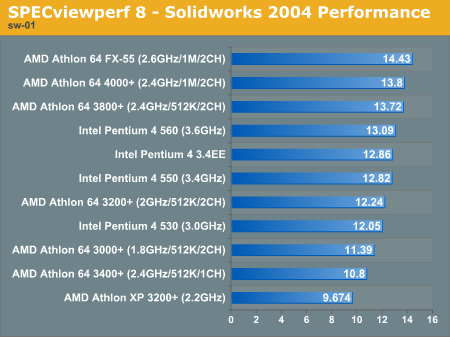
Unigraphics (ugs-04)
"The ugs-04 viewset was created from traces of the graphics workload generated by Unigraphics V17.
The engine model used was taken from the SPECapc for Unigraphics V17 application benchmark. Three rendering modes are measured -- shaded, shaded with transparency, and wireframe. The wireframe workloads are measured both in normal and anti-alised mode. All tests are repeated twice, rotating once in the center of the screen and then moving about the frame to measure clipping performance.
The viewset is based on a trace of the running application and includes all the state changes found during normal Unigraphics operation. As with the application, OpenGL display lists are used to transfer data to the graphics subsystem. Thousands of display lists of varying sizes go into generating each frame of the model.
To increase model size and complexity, SPECviewperf 8.0 replicates the model two times more than the previous ugs-03 test."
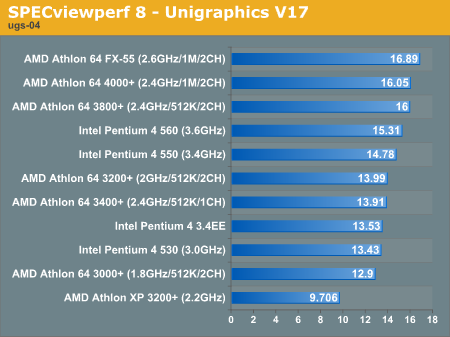
Power Consumption
To measure power consumption we looked at overall system power consumption and tried to keep as many variables static. There are some basic differences which we cannot get around, mainly that the 925X uses lower voltage DDR-II while the nForce4 uses regular DDR, but for the most part our results were quite controlled. We also included power consumption figures from 130nm Socket-939 Athlon 64 3200+ and 3000+ chips, which as you may know, do not exist. The reason we did this was to show the sharp contrast to the power consumption figures of the 90nm 3500+ we've included in the charts below.
We measured power consumption in two states: idle sitting at the Windows desktop and under load while running our Windows Media Encoder 9 test, which proved to be one of the most strenuous CPU tests we ran as it pretty much isolated the CPU subsystem.
At idle, the 130nm Athlon 64s all consume just about the same amount of power, with the 90nm Pentium 4s doing a little more. But what's truly impressive is the 90nm Athlon 64 3500+, drawing less power than any of the other chips at idle - by a significant margin.
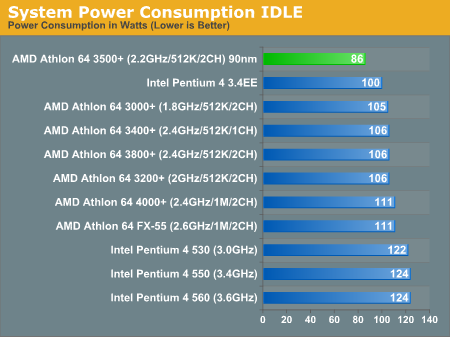
Under load the situation is no different; because of the fact that AMD didn't change anything architecturally (nothing major at least) with the 90nm shrink, the Athlon 64 got what the Pentium 4 should have received with the move down to 90nm - much lower power consumption. However, tack on 32-bit ALUs (as opposed to the 16-bit ALUs in the Northwood Pentium 4), a much longer and more power hungry pipeline as well as logic to support it, and you're looking at a much more power hungry chip. The 90nm Athlon 64 does not suffer this same fate and thus is almost a lower power chip compared to the competition here.
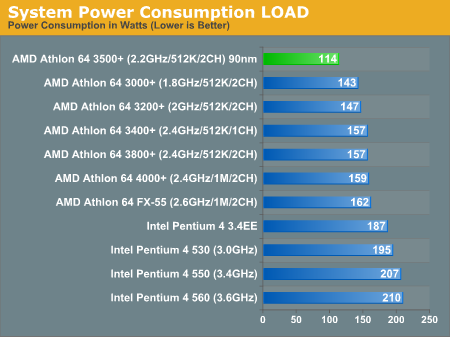
The Battle for Value: Athlon 64 3200+ vs. Pentium 4 530
In a review of processors selling for close to $1,000, it's important to look at some of the more affordable CPUs to see how they stack up against each other as well. With the introduction of the first 90nm Athlon 64 parts, AMD has been able to bring the Socket-939 Athlon 64 CPUs down below $300, making for an interesting value comparison.
Using our RealTime Pricing Engine we found that for just over $200 you could either have an Athlon 64 3200+ or a Pentium 4 530 (3GHz). While this doesn't take into account motherboard cost, 925X boards and Socket-939 boards are in the same general price ranges. You can get a Socket-939 nForce3 board for $133, and you can get an ABIT 925X board for $150.
So the question becomes, based on our plethora of benchmarks, which CPU do you buy? In order to find out, we'll break down the benchmarks by category once again.
In our Business/General Use tests, the Athlon 64 3200+ won 6 benchmarks, tied in 1 and lost 3. In the 6 benchmarks that the Athlon 64 3200+ won, its average win percentage over the Pentium 4 530 was 17.6%. In the 3 that the Pentium 4 530 won, its average win percentage was also a hefty 9.6%. Overall it would seem that the Athlon 64 3200+ is the better buy for Business/General Use, although the Pentium 4 did manage to outperform it in some tests.
In our Multitasking Content Creation tests, the Athlon 64 3200+ won 2 benchmarks and the Pentium 4 530 won 3 benchmarks. In the two benchmarks the 3200+ won, it outperformed the 530 on average by 12.8%. In the three benchmarks the 530 won, it outperformed the 3200+ by 10.2%. Although the Athlon 64 won fewer benchmarks here it won by a larger overall percentage so we'll call this one a draw.
Next up is Video Creation/Editing and Photoshop performance, where the 3200+ won 2 out of the three tests by outperforming the 520 by 22.8% on average. The Pentium 4 won one test by a margin of 2.5%. The clear winner here is AMD.
Audio/Video encoding gave the Athlon 64 two wins at an average of 11.9%, while the Pentium 4 530 had 3 wins at an average of 11.3%. Given the virtually equal performance wins with a slight difference in the number of wins, we'll call this one a slight victory for Intel.
If you're a gamer, the choice is clear, the Athlon 64 3200+ won 10 out of 10 gaming benchmarks with an average performance advantage of 13.9% over the Pentium 4 530.
In our 3dsmax 3D rendering tests, the Athlon 64 won twice while the Pentium 4 one once. However the one test the Pentium 4 won in was actually a composite of 4 separate 3dsmax tests which we also included in our results. The Athlon 64 advantage in its two wins was 7.7%, while the Pentium 4 advantage in its wins was an average of 7%. With 4 actual victories over AMD's 2, our recommendation here would be leaning more strongly towards Intel but the win is definitely not clear cut.
Finally in our workstation tests, the Athlon 64 won 7 benchmarks, the Pentium 4 won one by 1% and failed one. The performance advantage here was an average of 8.4%, giving the advantage to AMD.
In the end, here's our scorecard for the Athlon 64 3200+ vs. Pentium 4 530:
Business/General Use - Athlon 64 3200+
Multitasking Content Creation - Tie
Video Creation/Editing and Photoshop - Athlon 64 3200+
Audio/Video Encoding - Pentium 4 530
Gaming - Athlon 64 3200+
3D Rendering with 3dsmax - Pentium 4 530
Workstation Performance - Athlon 64 3200+
Depending on your usage our recommendation may vary, but the best overall performer at the $200 price point appears to be the Athlon 64 3200+.
Justifying a Rating: Athlon 64 4000+ vs. Athlon 64 3800+
Given difficulty hitting 2.6GHz on the 130nm process, AMD rebadged the FX-53 as an Athlon 64 4000+, making the only difference between it and the 3800+ a matter of 512KB of L2 cache as they both run gait 2.4GHz. But this leaves us with a very important question, does the additional L2 cache actually justify an increase in model number? Remembering that the Athlon 64 has an on-die memory controller it's obvious that the CPU will benefit less from a larger cache than something like the Pentium 4, which does not have the benefit of always having extremely low latency memory accesses. It's even more important to look at this rating carefully since we have no comparison point from Intel as there will be no 4GHz Pentium 4. Armed with this question of justification, let's look at what our results have told us:
In Business/General Use tests, the Athlon 64 4000+ offered the exact same performance as the 3800+ in three tests, and outperformed its predecessor by an average of 3.8% in 7 tests. Given AMD's 5% increase in model number, we'd say that when it comes to Business/General Use performance, the processor has earned its keep.
In the Multitasking Content Creation tests, the 4000+ averaged a 4.5% advantage in two of the five tests, but offered no performance improvement in the remaining three. Here we have a more questionable use of the 4000+ rating.
In the Video Creation/Photo Editing tests, the 4000+ was actually faster in all of the tests, but only by an average of 0.8% - definitely not justifying the rating increase.
Looking at A/V Encoding, the 4000+ tied with the 3800+ in one test and outperformed its predecessor by 1.2% on average in the remaining 4 tests - here we have, once again, much more borderline use of the 4000+ rating.
As far as gaming performance goes, the Athlon 64 4000+ offers a performance improvement in 8 out of our 10 tests, averaging 3.1% faster than the 3800+. Considering we're talking about a rating increase of 5%, that's not too bad.
The Athlon 64 4000+ averaged 3.9% faster than the 3800+ in two out of the three 3dsmax rendering tests, somewhat justifying its rating considering that the one test it did not show an improvement in was a geometric mean of four individual render times.
Finally in our Workstation performance tests the Athlon 64 4000+ barely offers any improvement over the 3800+. In 8 out of the 9 tests the 4000+ averaged 0.6% faster than the 3800+, while offering no performance gain in the remaining test.
So what does the Athlon 64 4000+'s scorecard look like? Does it earn its rating?
Business/General Use - Yes
Multitasking Content Creation - Yes
Video Creation/Editing and Photoshop - No
Audio/Video Encoding - No
Gaming - Yes
3D Rendering with 3dsmax - Borderline
Workstation Performance - No
So despite the increase in model number, the Athlon 64 4000+ gives very little reason for rejoice other than for hopefully cheaper 3800+ prices.
Re-evaluating the Benefits of Socket-939
Given that pretty much the fastest processors are available on both Socket-754 and Socket-939 platforms for the Athlon 64, we have to once again look at the performance improvement brought by a 128-bit memory interface to see if Socket-939 is truly worth it from an overall performance standpoint. Understanding that the upgrade path is much brighter with Socket-939, it is still important to evaluate present-day performance benefits. So, is Socket-939 worth it from a broad standpoint? In order to find out we compared two identical processors: the Athlon 64 3800+ and the Athlon 64 3400+. Both run at the same 2.4GHz clock speed and feature the same 512KB L2 cache, the only difference is that one processor has a 128-bit memory interface while the other has a 64-bit memory interface. Let the games begin:
In our Business/General Use tests, the 128-bit memory interface of the 3800+ was responsible for an average of a 5.4% performance advantage over the Socket-754 part, only tying in one benchmark.
In our Multitasking Content Creation tests, the Socket-939 platform pulled ahead in all tests by an average of 3.2%.
In the Video Creation/Photo Editing tests, the Socket-939 platform pulled ahead, once again, in all tests by an average of 4.2%.
The Socket-939 platform pulled ahead by an average of 4.4% in four out of the 5 A/V encoding tests.
In the gaming tests, the 128-bit Socket-939 memory interface caused an average performance advantage of 6.3% across all tests.
Surprisingly enough, in the 3D Rendering tests with 3dsmax, Socket-939 offers a 5.4% performance advantage - once again, across all tests.
Finally in our Workstation tests we find the biggest supporter for Socket-939, the platform allows for an average improvement over over 17%.
From our standpoint, the recommendation for Socket-939 is clear, although rest assured that if you are on a budget you can get away with Socket-939-like performance with a Socket-754 platform in certain performance categories. Although workstation users will definitely want to spring for the 939 platforms, and with the introduction of the new 90nm Socket-939 parts, the platform should become even more affordable. It's worth going down one speed grade in order to get a Socket-939 platform in our opinion, not only for the small to reasonable performance improvements but also because of the much safer upgrade path.
Final Words
As we've shown just in the final pages of this review, AMD's launch of the Athlon 64 4000+ doesn't mean all that much other than bragging rights. The justification of the rating is questionable, as is the release of the processor, since it is little more than a rebadged FX-53 with some of its overclocking appeal removed. The fact that Intel has pulled the launch of the Pentium 4 4GHz while AMD has come to market with a 2.4GHz Athlon 64 4000+ doesn't mean much, but there is little to complain about since AMD has many more attractive Athlon 64 options.
What the cancelation of Intel's 4GHz Pentium 4 does say however is that Prescott was a waste. Intel would have done a much better job of competing had 90nm been simply a die shrink and done without the architectural "enhancements" of Prescott designed to ramp up clock speeds. Granted hindsight is 20-20 and we can't blame Intel for not having that knowledge of the future, but we can say that once again, it looks like AMD made the right bet, this time with reference to their 90nm strategy. We would strongly recommend any of AMD's 90nm parts thanks to their significantly lower power consumption, competitive price as well as their performance.
It is worth noting that after the Athlon 64 3500+, AMD doesn't really have many price-competitive options with Intel. The 3800+ and 4000+ compete in a price segment that even Intel's Pentium 4 560 won't touch, making Intel's flagship desktop processor cheaper than AMD's similar offering - a first if we've ever seen one. So although the Athlon 64 3800+ and 4000+ are very strong performers, you're definitely paying for them. Although it is worth noting that even the FX-55 is cheaper than Intel's Pentium 4 3.4EE.
The introduction of the FX-55 with strained silicon technology is an interesting and unexpected move from AMD, at least at this point. We knew they were planning an FX-55, but we had no idea it would include strained silicon support - the question of when we'll see strained silicon and higher clock speeds at 90nm does still remain.
With 2004 quickly coming to a close, we can't help but wonder if this will be the last year for the foreseeable future where we will have a processor speed war to talk about. With 2005 destined to be the year of multiple cores, and with dual core solutions from both AMD and Intel guaranteed to run at lower clock speeds than present day single core chips, are the great MHz and GHz races of years past on hiatus for a while?
What about software support for multi core processors? Although Intel has happily shipped over 50 million Hyper Threading enabled Pentium 4s in just over two years, the vast majority of desktop applications are still not multithreaded. Will the introduction of dual core CPUs be a clever way of weaning the populous off of fast CPUs so that lower clocked, slower overall, multi core CPUs can tide us over until performance actually improves? The prospects are interesting.
We expected Intel to launch Hyper Threading with killer applications and benchmarks that would truly show its necessity on the desktop, but we were rather surprised to see that the best we got two years ago were some scripts that simulated isolated situations. Our fears are that 2005 will hold a repeat of Intel's HT launch on the desktop; while no one is arguing that dual core won't have a future, we're wondering if it may come a bit too soon to actually do anything. Obviously only time will tell, but until then don't expect too many more speed bumps from either Intel or AMD. It seems like both camps are going to be increasing cache sizes and playing with other architectural tweaks in the near future before they can get dual core out the door.







